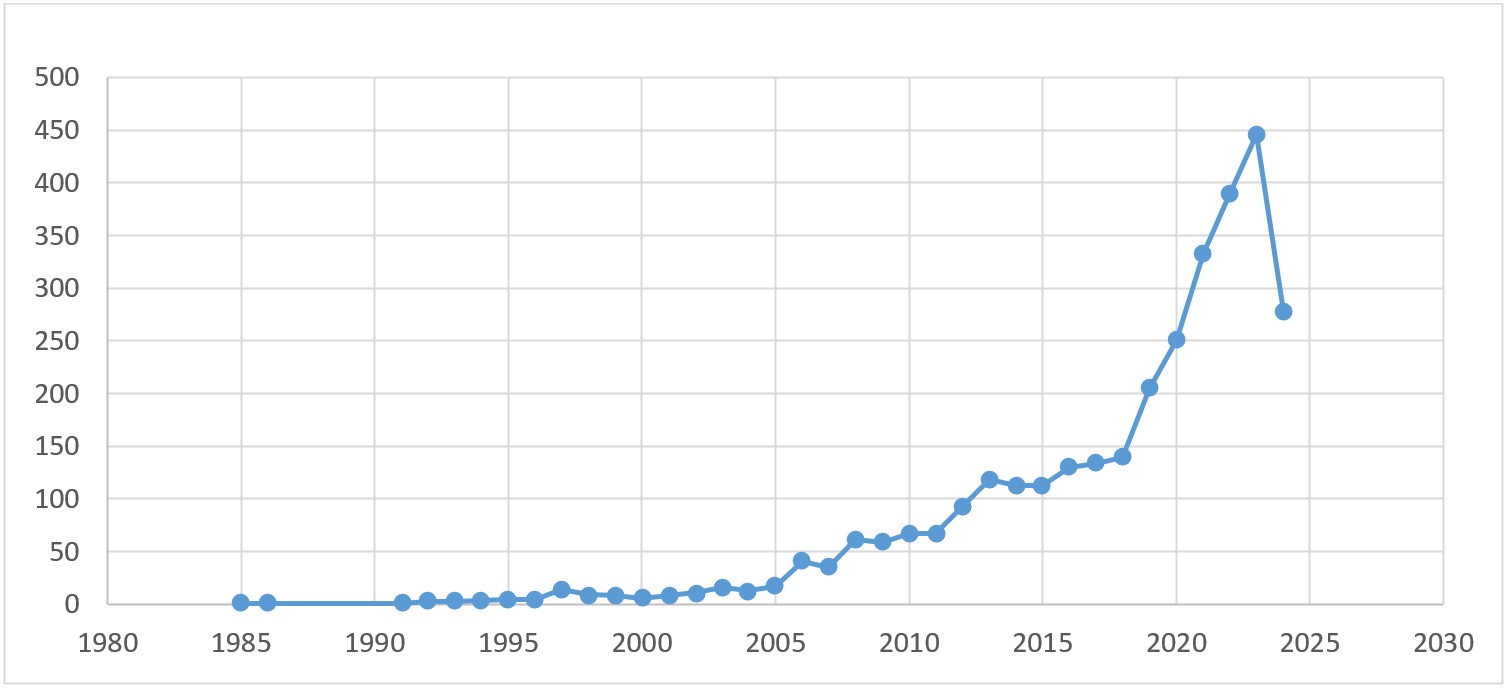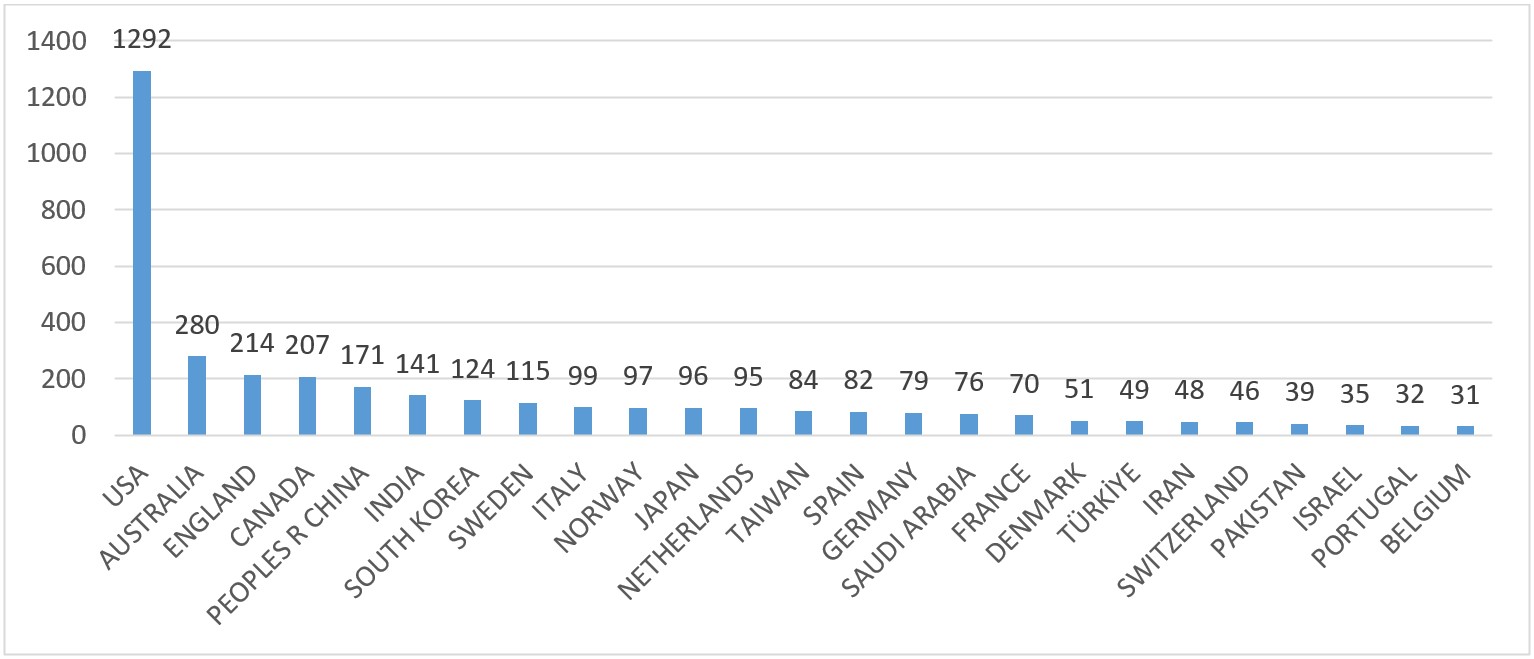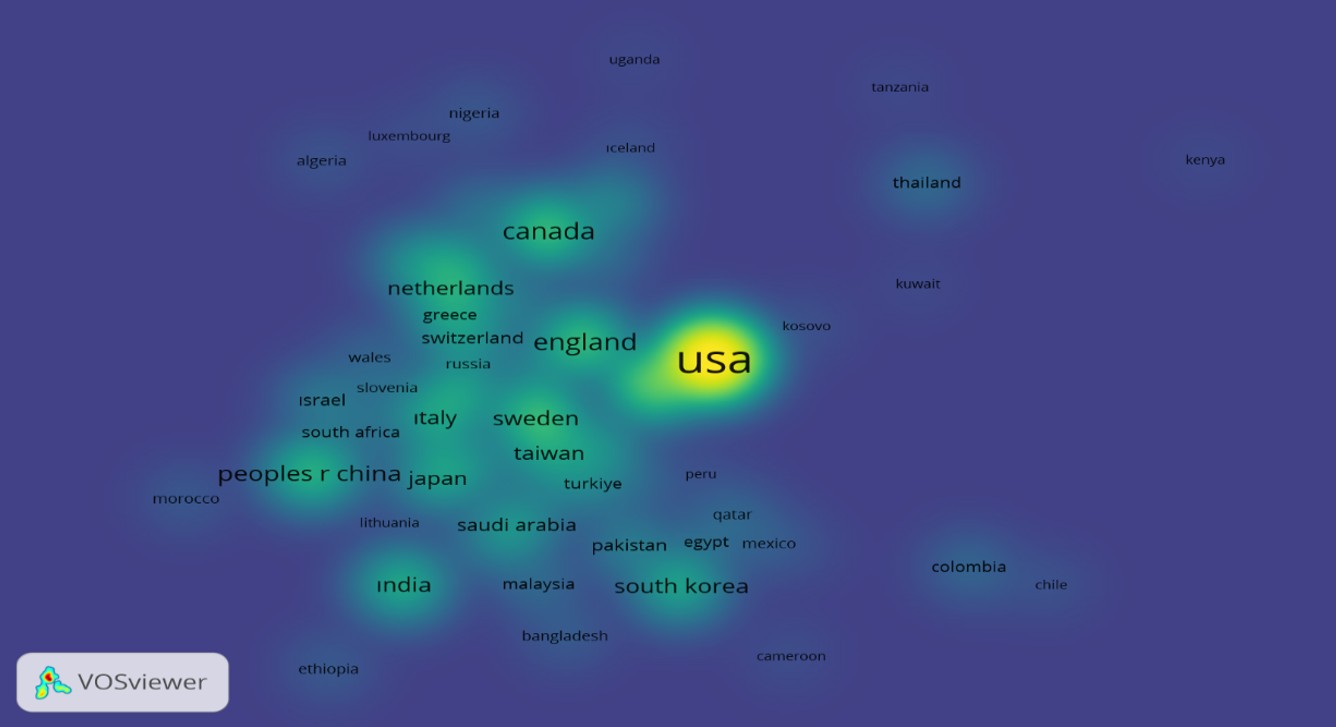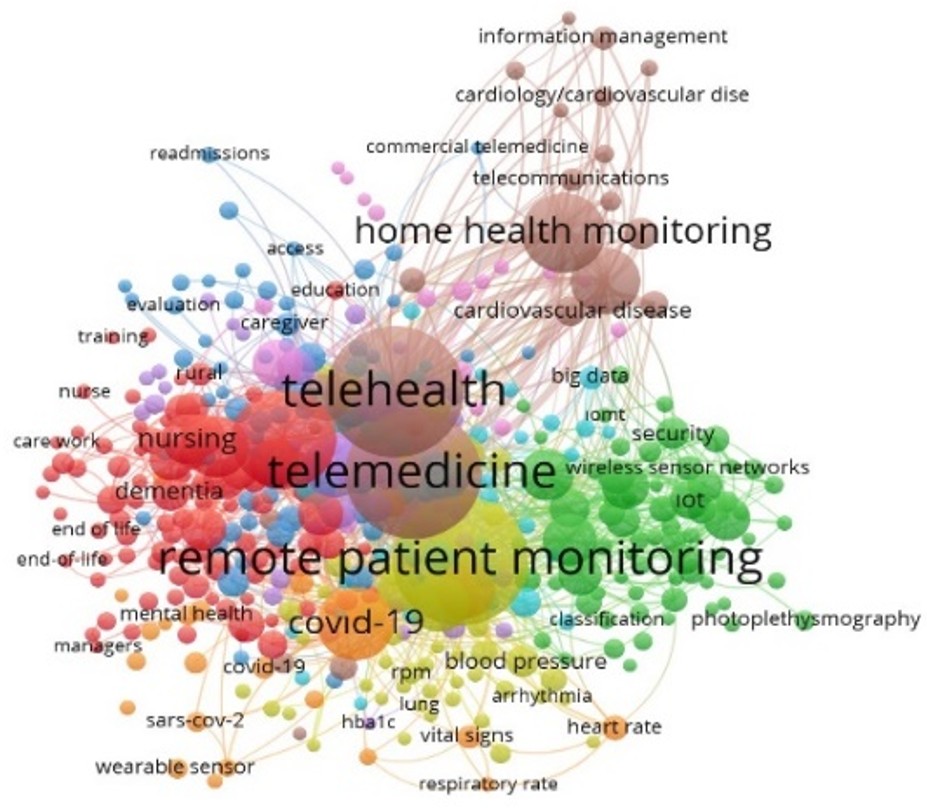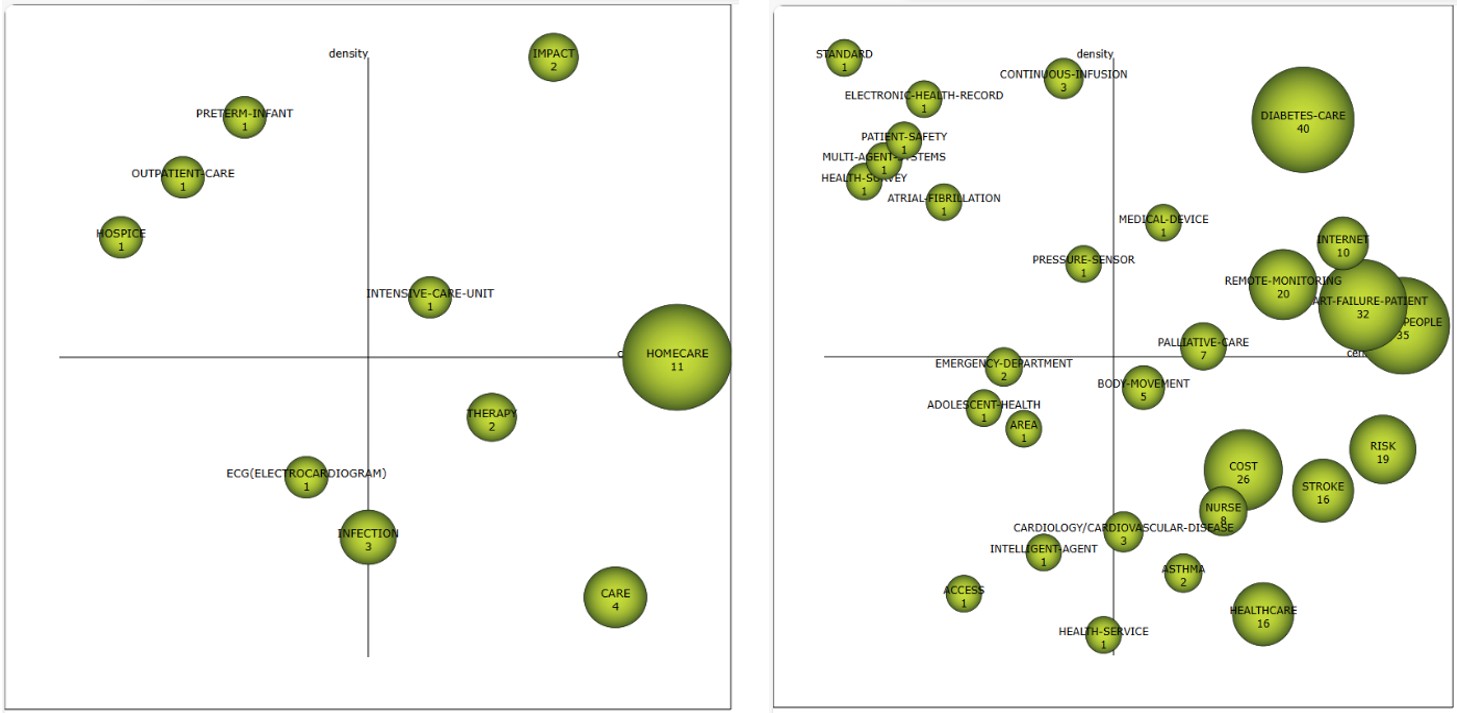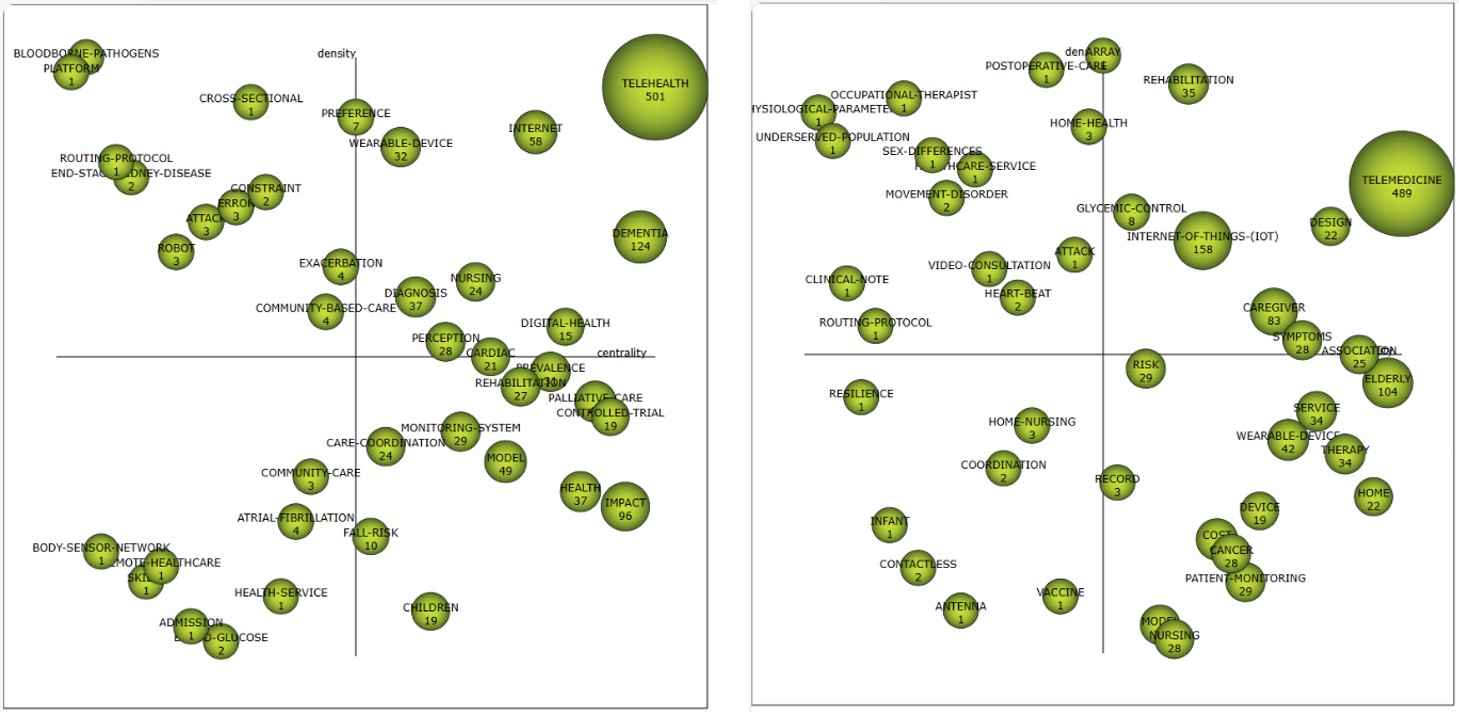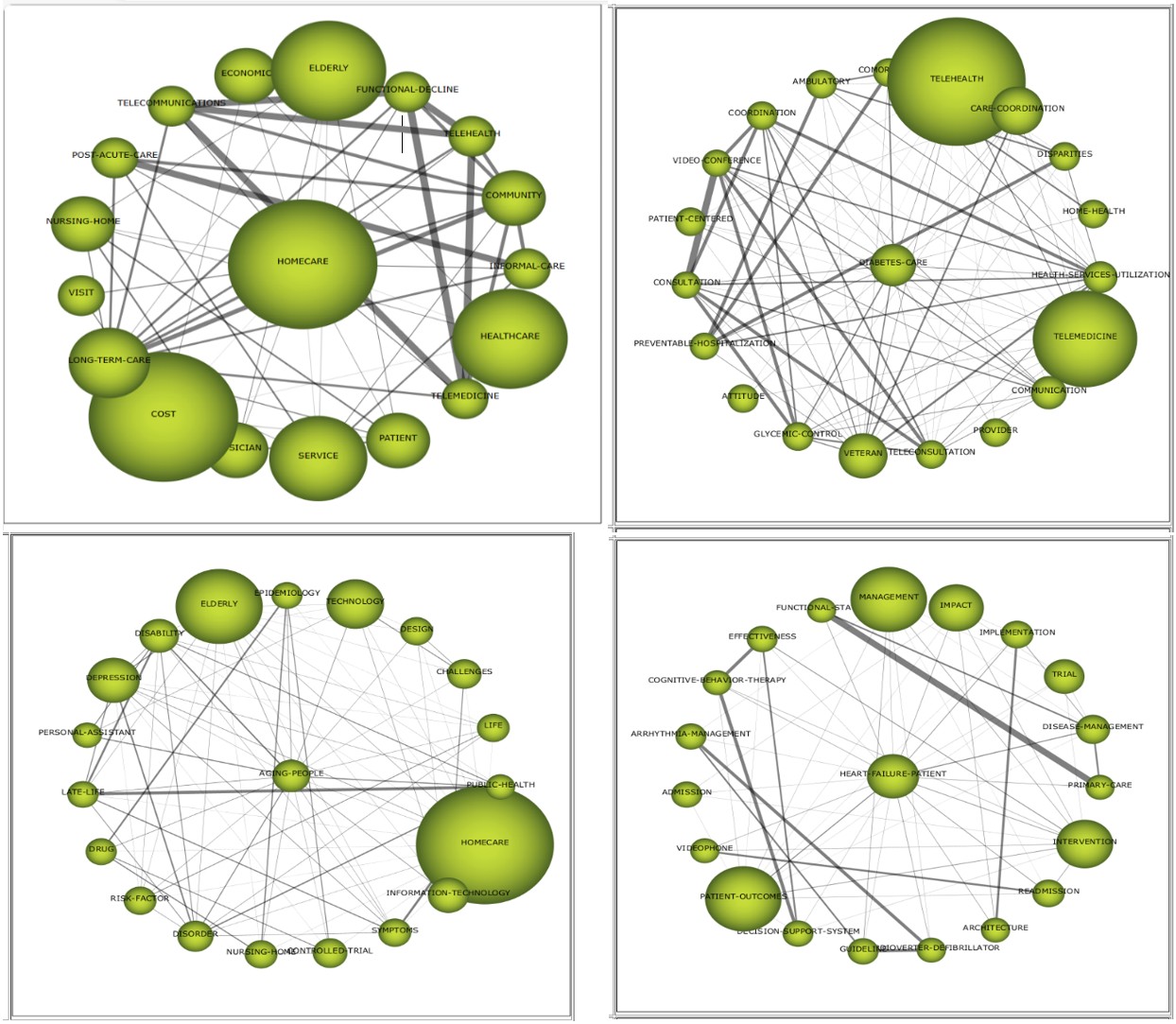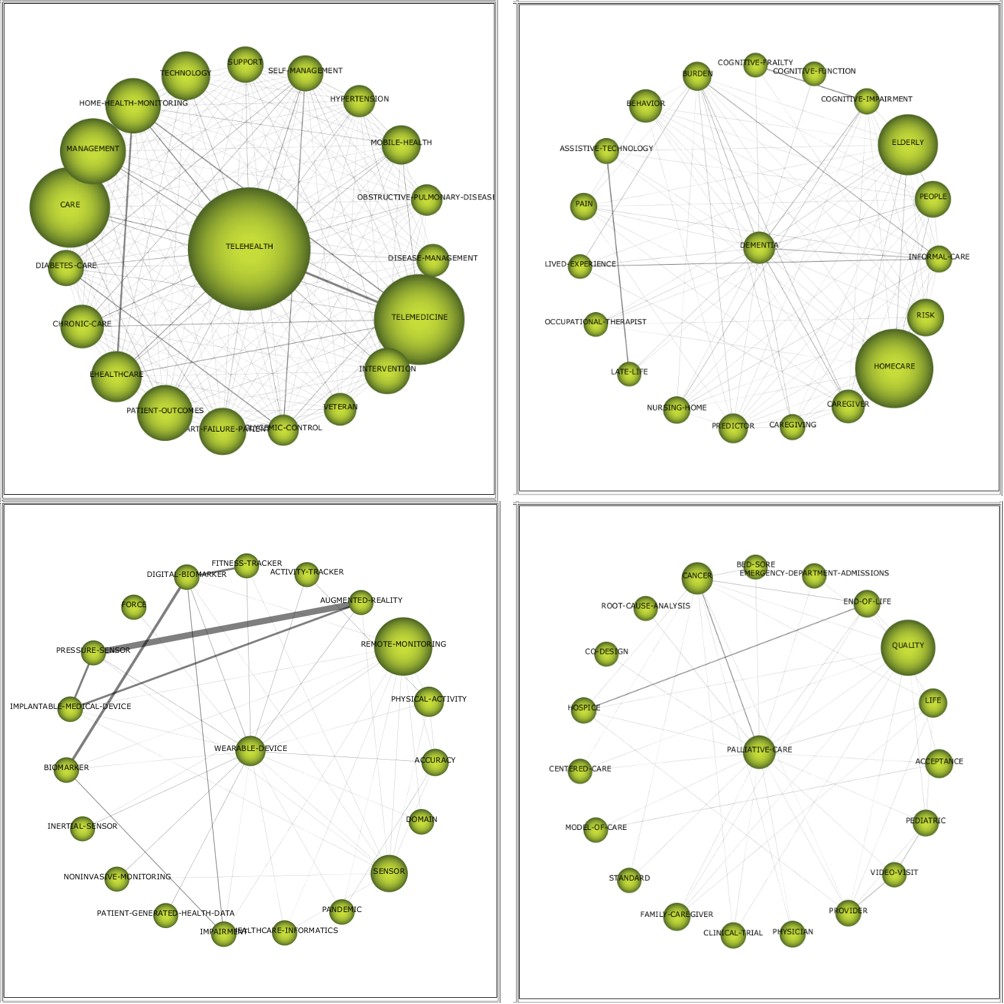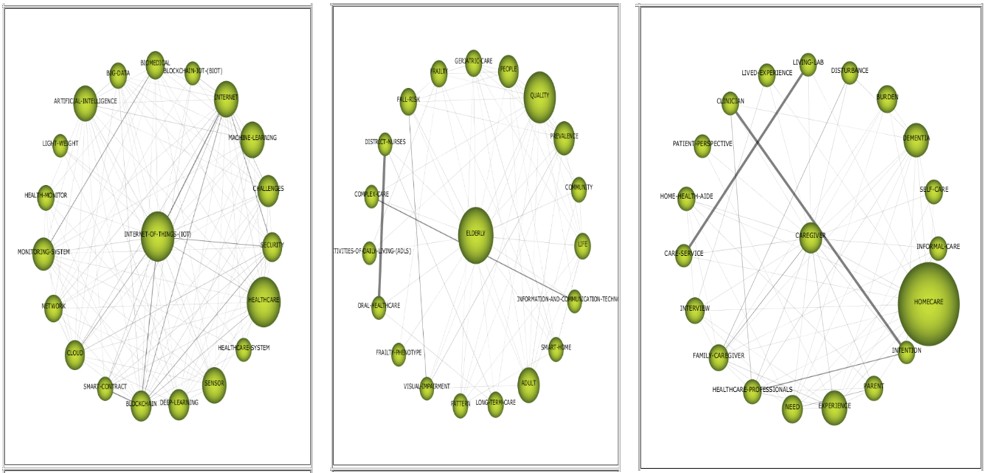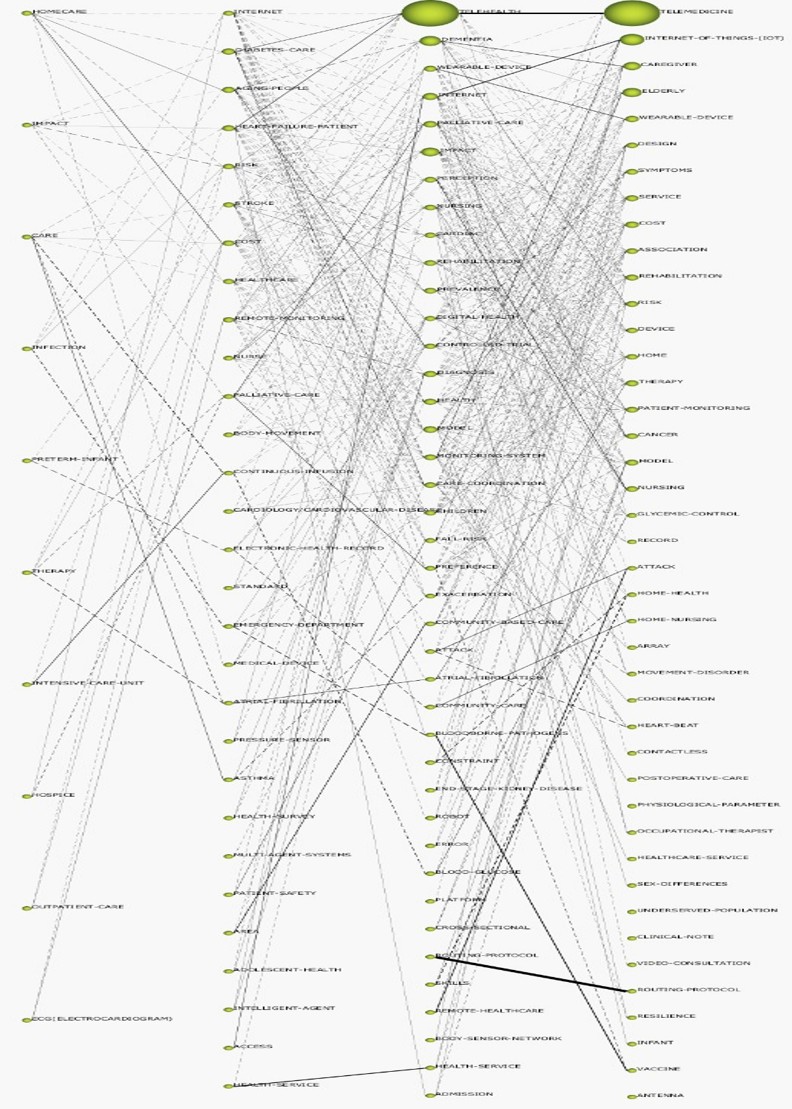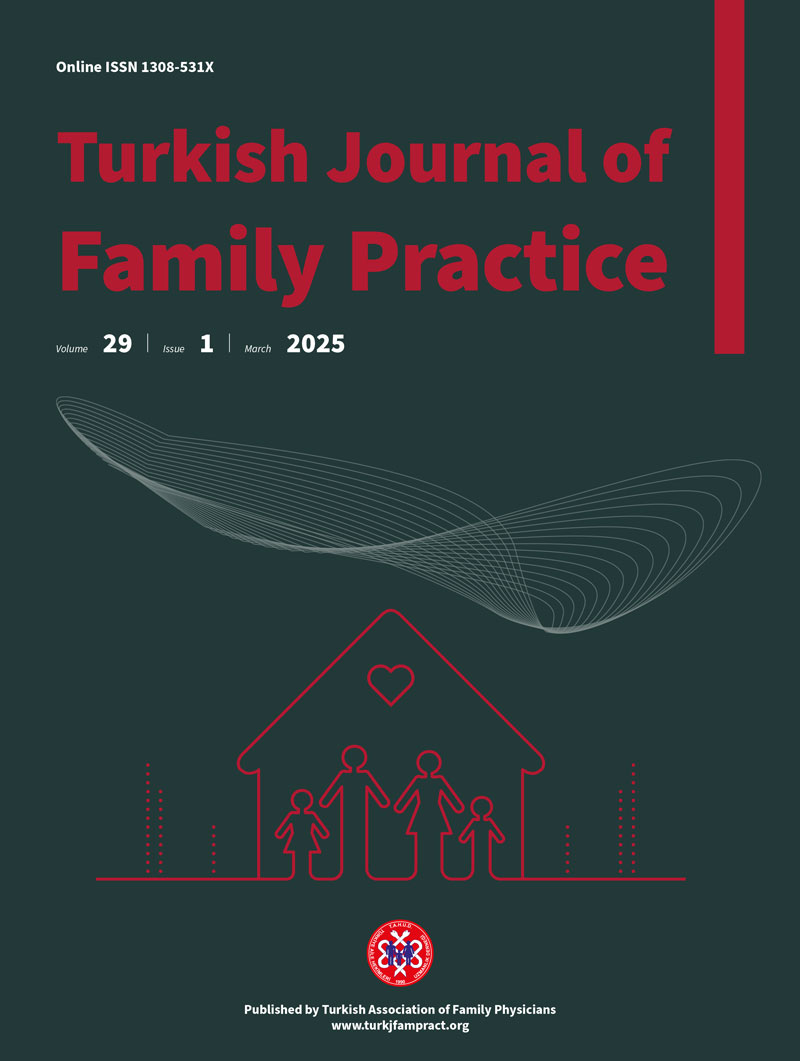Abstract
Background: In addition to being cost-effective, home health services are preferred for the patient. Recently, there have been developments integrating home health services with telehealth. This study aims to analyze published studies on telehealth applications in home health services using the bibliometric method.
Methods: Data were obtained from the Web of Science Core Collection database on 10.08.2024. Year restrictions were not applied, and publications in English were selected. The search used the keywords ‘homecare’ OR ‘home healthcare’ OR ‘hospital in the home’ AND ‘telehealth’ OR ‘remote.’ VOSviewer and SciMAT software were used for the analysis. Publications were analyzed based on author, country, number of citations, keywords, index, year of publication, and research area. The period from 1985 to 2024 was divided into four periods, and strategic diagram analyses were performed.
Results: A total of 3197 publications were identified. The top three countries with the highest number of publications are the USA, Australia, and England. The most frequently used keywords are ‘telehealth’, ‘telemedicine’, and ‘remote patient monitoring’. The theme was “homecare” in the first period. “diabetes care”, and “internet”, “aging people” were prominent in the second period, while “telehealth”, “dementia”, “wearable device”, and “palliative care” were significant in the third period. In the fourth period, the themes were “internet of things”, “elderly care”, “caregivers”, and “wearable devices”.
Conclusion: Telehealth has started to be more widely used in home health services due to technological advancements. The increasing interest in following and treating individuals with chronic diseases and patients in need of palliative care at home is attributed to patient-centered service provision.
Keywords: home health care, home care service, telehealth, telemedicine
Introduction
Healthcare systems across the world have traditionally focused on centralized delivery of care within hospitals. However, recent developments have shifted the focus towards providing healthcare services to individuals in their own homes.[1] With the increasing demand for healthcare services and the need to control costs, health systems need to make concerted efforts to ensure sustainability.[2] Home health services are a key component in addressing these challenges.[3]
Home health services encompass a wide range of continuous and comprehensive healthcare services delivered to individuals and families in their own homes. The aim is to improve, maintain, or restore health, maximize independence, and minimize the impact of disease. These services can include promotive, preventive, curative, and rehabilitative care, or a combination of these.[4] They cover various levels of care needs and health problems experienced by individuals living at home, and are provided by health professionals from different public, private, or non-profit organizations.[5,6]
Home health services play a crucial role in preventing overcrowding and bed occupancy in hospitals, while also being a cost-effective method. Additionally, they offer psychological benefits for the patient and their family, as well as increasing satisfaction with health services. These services contribute to reducing mortality, complication rates, readmission rates, length of hospitalization, and financial pressure on health systems.[2,7] Along with being cost-effective, home health care is a preferred form of care delivery for both the patient and caregiver.[8,9] It is also an effective way to manage chronic diseases through care provided by a multidisciplinary team of skilled members.[10] Home health services can monitor and treat a variety of acute and chronic conditions, including chronic obstructive pulmonary disease (COPD), chronic kidney disease (CKD), chronic heart failure, and post-acute myocardial infarction. Furthermore, it can provide rehabilitation, home nutrition, intravenous therapy, wound care, chemotherapy, and even home clinical care for acute diseases requiring inpatient treatment.[2,7,11]
Today, home healthcare services, where the healthcare professional provides services by going to the patient’s home, have blended with virtual care thanks to technological methods such as telemedicine and telemonitoring.[2,7] There are some reasons that trigger the use of telehealth technologies in home health services. The first of these is the prolongation of life expectancy worldwide, especially in developed countries, and the pressure of the increasing elderly population on health systems.[10] Elderly individuals usually have multiple chronic diseases and need healthcare services at frequent intervals. The hospitalization rate of individuals with multiple chronic diseases is over 20% within one year.[12,13] However, elderly individuals prefer to live independently in their own homes as much as possible. Integrating smart technologies into the healthcare system is important to support the elderly population with chronic diseases.[12] Not only individuals with chronic diseases but also the majority of those who need palliative care prefer home care.[14,15] There is a transition from hospital-based palliative care to community-based palliative care because it is both suitable for the patient’s preferences and prevents the high cost of hospitalisation.[16] However, patients receiving palliative care services at home may have concerns such as lack of continuous communication with healthcare professionals, uncertainty about who to contact in times of need, and poor continuity of care. The use of health technologies is shown to be a good solution to address these concerns and ensure continuity of care. Home health technologies used for this purpose help the patient’s symptom control and provide psychological support, effective communication with healthcare professionals and a sense of trust.[14,15] The second reason is the declining health workforce. Especially in palliative care and home care services, labour force participation is low, while turnover rates are high.[3,7,17] Telehealth can be an effective method to overcome the shortage of health personnel.[18] The third reason is the impact of the COVID-19 pandemic. In order to reduce the pressure on hospitals due to the increasing demand for healthcare services caused by the pandemic, home healthcare services have been emphasised. Non-severe COVID-19 cases and individuals with chronic diseases requiring continuous follow-up and treatment were followed and treated at home.[11,19] During the pandemic period, the number of face-to-face visits was reduced in order to protect elderly patients with chronic diseases who benefited from home care and, moreover, the healthcare personnel providing services to them from infection, and service delivery was carried out via telephone or video-conference.[20]
Telehealth is defined as the provision of remote healthcare services through various telecommunication tools.[15] The terms telehealth or telemedicine refer to the exchange of medical information from one site to another via electronic communication to provide clinical care and improve the patient’s health.[11] Telehealth allows for diagnosis, treatment, and prevention, as well as research, evaluation, and education for the patient and their relatives. It particularly benefits those in rural areas, those with young children, and those with mobility limitations by improving access to health services. Telehealth has many advantages, such as improving the patient’s quality of life, reducing hospital costs, saving time, and increasing user satisfaction.[4] Telehealth applications in home health provide effective communication between health professionals, patients, and their relatives, increasing access to health professionals.[16] Continuous monitoring through tele-home health can detect early warning signs in chronic diseases, allowing patients and their relatives to be trained on medicine use, nutrition, and physical activity practices.[13] Tele-home health has been found to have positive effects on patient clinical outcomes by reducing readmissions, emergency department visits, and mortality, while also strengthening patients’ self-management and increasing their sense of safety and security.[13,15,16,21] Furthermore, telehealth improves communication and information sharing between patients, healthcare professionals, and healthcare institutions, leading to better decision-making and reduced costs.[14] Additionally, telehealth can reduce the patient’s traveling burden and provide access to services outside clinic hours.[15]
An article published in the Lancet in the 1870s mentioned the advantages of telehealth, demonstrating that its discovery is not new. However, current health system conditions and the advantages obtained with the use of telehealth have increased its utilization.[11] The growing use of telehealth in home health services is expected to lead to an increase in research studies within this context. It is also anticipated that the challenges, benefits, and obstacles encountered during the implementation process will be reflected in these studies over time. This research aims to track the evolution of various perspectives, findings, and results on the subject as time progresses. This study aims to examine the use of telehealth in home health services through bibliometric analysis. This allows researchers to track the literature’s development, evaluate the quality of published studies, and identify the main themes of the research. The findings can provide a reference for researchers and health management professionals to improve the quality and efficiency of home health services.
Method
In this retrospective study, data obtained from the Web of Science database were utilized. The study does not require approval from an ethics committee, as it is retrospective and informed consent is not required.
Statistical analysis
Bibliometric methods involve analyzing the studies published on a specific subject numerically. It helps researchers reveal the performance analysis or scientific mapping of publications on a subject.[22]
The Web of Science (WoS) database is commonly used in bibliometric studies due to its comprehensive coverage of publications from various disciplines. The data for the study was obtained from the WoS Core Collection database on 10.08.2024, with no year restrictions in the search. Only English language publications, including ‘article’, ‘review article’, and ‘early access’ publications were selected, while book chapters, congress proceedings, and other non-article publications were excluded. The search used the keywords ‘homecare’ OR ‘home healthcare’ OR ‘hospital in the home’ AND ‘telehealth’ OR ‘remote’.
The data was analyzed using VOSviewer 1.6.18 and SciMAT 1.1.06 software.[23] Publications were analyzed in terms of author, country, number of citations, keywords, index, year of publication, and research area. The period from 1985 to 2024 was divided into four periods, and a strategic diagram analysis was conducted for these periods.
Results
Since 1985, a total of 3197 publications have been produced. Of these, 2810 are articles, 384 are review articles, and 83 are in early access.
When we categorize the publications based on the type of index, we find that 76.7% of them are within the Science Citation Index Expanded (SCI-Expanded), 35.3% are within the Social Sciences Citation Index (SSCI), 17.2% are within the Emerging Sources Citation Index (ESCI), and 0.1% are within the Arts & Humanities Citation Index (A&HCI).
The majority of publications in the research area were in the fields of Health Care Sciences Services (n=855), Engineering (n=415), and Computer Science (n=376). This indicates that the subject is multidisciplinary, with studies conducted in various fields including the health sector (such as Nursing, General Internal Medicine, and Cardiovascular System Cardiology), informatics (Medical Informatics, ScienceTechnology Other Topics, Telecommunications), and business (BusinessEconomics).
The first publication in the field of research was made in 1985. The number of publications has been increasing over the years, especially after 2010, there has been a rapid increase in the number of publications. The increase in the number of publications has gained momentum since 2018 (Figure 1).
There are publications from 91 countries in total. The top three countries with the highest number of publications are USA, Australia and England. Türkiye ranks 19th with a total of 49 publications (Figure 2).
When the number of citations of publications by countries was analysed, it was seen that 6 countries were not cited at all. The 5 most cited countries were USA (27,591), Australia (5,916), Canada (5,192), Peoples R China (5,133) and England (4,711). Compared to other countries, it is seen that the publications produced in the USA are dominant in terms of citation (Figure 3).
A total of 13,588 authors were identified. When ranking the authors, we considered at least 1 publication and at least 1 citation. It was found that 11,522 authors met these criteria. Table 1 displays the top five authors with the highest number of publications, along with their respective publication and citation counts.
| Table 1. Top 5 authors with the most publications | ||
| Author(s) | Publications (n) | Total Citations (n) |
| Bowles, KH | 21 | 218 |
| Topaz, M | 18 | 111 |
| Montalto, M | 18 | 323 |
| Najafi, B | 18 | 211 |
| Zhang, Y | 17 | 551 |
It was found that 503 of the publications included in the research were not cited at all. When the search was narrowed down to studies with at least 5 citations, 1,895 publications meeting this criterion were identified. Table 2 presents detailed information about the top 5 most cited studies.[24-28]
| Table 2. The Most influential publications (top 5) [24-28] | ||
| Rank | The Most Influential Publications | Citation (n) |
| 1 | Mann DM, Chen J, Chunara R, Testa PA, Nov O. COVID-19 transforms health care through telemedicine: evidence from the field. J Am Med Inform Assoc. 2020;27(7):1132-1135 | 835 |
| 2 | Ekeland AG, Bowes A, Flottorp S. Effectiveness of telemedicine: a systematic review of reviews. Int J Med Inform. 2010;79(11):736-771. | 676 |
| 3 | Ong MK, Romano PS, Edgington S, et al. Effectiveness of remote patient monitoring after discharge of hospitalized patients with heart failure: the better effectiveness after transition–heart failure (BEAT-HF) randomized clinical trial. JAMA Intern Med. 2016;176(3):310-318. | 429 |
| 4 | Yang G, Xie L, Mäntysalo M, et al. A health-IoT platform based on the integration of intelligent packaging, unobtrusive bio-sensor, and intelligent medicine box. IEEE Trans Ind Inform. 2014;10(4):2180-2191. | 378 |
| 5 | Almathami HKY, Win KT, Vlahu-Gjorgievska E. Barriers and facilitators that influence telemedicine-based, real-time, online consultation at patients’ homes: systematic literature review. J Med Internet Res. 2020;22(2):e16407. | 370 |
A total of 7,043 keywords were used in the studies. The keywords were scanned, with 5 or more keywords meeting the criteria identified. A total of 419 keywords met this criterion. The top five most frequently used keywords, without discrimination according to years, are shown in Table 3.
| Table 3. The 10 most frequently used keywords | ||
| Rank | Most Frequent Keywords | Cited (n) |
| 1 | Telehealth | 414 |
| 2 | Telemedicine | 406 |
| 3 | Remote Patient Monitoring | 402 |
| 4 | Home Healthcare | 238 |
| 5 | Home Health Monitoring | 157 |
| 6 | Covid-19 | 133 |
| 7 | E-Health | 110 |
| 8 | Home Care | 93 |
| 9 | Heart Failure | 86 |
| 10 | Digital Health | 80 |
The analysis of the keywords used is depicted in Figure 4. There is a strong relationship between the keywords “telehealth,” “telemedicine,” and “home health monitoring,” which are sometimes used interchangeably in the literature. “Remote patient monitoring” and “COVID-19” are also prominent keywords. The keywords “blood pressure,” “arrhythmia,” and “vital signs” are associated with the keyword “remote patient monitoring.”
The most cited studies are shown in Figure 5. Accordingly, Mann (2020), Almathami (2020), Yang (2014) are the most cited studies.
In the study, the publications on the subject were analysed by dividing them into four periods. The periods were determined as follows.
- 1st Period is between the years 1986-2000
- 2nd Period is between the years 2001-2010
- 3rd Period is between the years 2011-2020
- 4th Period is between the years 2021-2024
In Figure 6, it is evident that 68 keywords were used in the initial period, and 60 of these were also used in the subsequent period. The total count of keywords reached 284, with 224 new keywords introduced in the second period. For the third and fourth periods, the number of keywords used exceeded five hundred.
Homecare, which is the main field of study in the first period, has a centrality value of 76.52 and a density value of 98.56. In this period, the homecare theme constitutes the research centre. Themes that are important for the research area but need to be developed are found to be care and therapy themes. The more specialised topics that the methodology used labelled as ‘peripheral’ are preterm-infant, outpatientcare and hospice. In the lower left quadrant is ECG (electrocardiogram), which has low centrality and density. When the strategic diagram of the second period is analysed, the increase in the number of themes is noteworthy. In this period, the clusters on the top right with high centrality and density are diabetes care (c=149.88, d=68.74) and aging people (c=182.01, 35.25). Themes that need to be developed are nurse, cost, stroke and risk. Special themes include continious-infusion, electronic-health-record, patient-safety and atrial-fibrillation. Emergency-department, adolescent-health, intelligent-agent and acces have low density and centrality (Figure 7).
In the third period, the main themes were telehealth (c=147,01, d=25,36), dementia (c=132,41, d=11,61), wearable device (c=66,96, d=18,09), and palliative care (c=89,37, d=5,36). Rehabilitation, palliative-care, monitoring-system and care-coordination clusters were found as themes that need to be developed. In the upper left corner of the diagram, rouing-protocol, kidney-disease, constrain and robot clusters are seen. In the lower left corner, community-care, atrial-fibrillation, blood-glucose clusters are present. In the fourth period, internet of things with 75.23 centrality and 14.43 heart values, elderly and caregiver with 108.96 centrality and 9.11 densities (c=84.56, d=12.26) stand out. In this period, wearable-device, therapy, cancer, nursing themes are important for the research topic but need to be developed. More specific themes include movement-disorder, hearth-beat. The themes of the fourth period with low centrality and intensity are home-nursing, coordination, contacless and vaccine (Figure 8).
The cluster networks of the keywords in the center during the periods examined are shown in Figure 9. Specifically, the word “Homecare” has a strong relationship with the words “telemedicine” and “telecommunication”. “Diabetes care” is strongly related to “preventable hospitalization” and “disparities”. There is a strong relationship between the aging people theme with the late-life and public-health themes and between the primary-care theme and the functional-health theme (Figure 9).
The relationship between telehealth and telemedicine; dementia and informal-care, lived-experince themes were found to be strong. Figure 10 show the network maps of wearable-device and palliative-care themes.
The network maps showing the relationship between the internet-of-things, elderly and caregiver themes, which are the main themes of the fourth period, and other themes are presented in Figure 11.
The scientific map illustrated in Figure 12 demonstrates the evolution and interconnections of scientific concepts throughout specific periods related to the study topic. By pinpointing which concepts are prominent in various years, this analysis provides a deeper understanding of conceptual evolution through time series analysis. This longitudinal analysis allows researchers to understand how literature has evolved over time and provides a comprehensive view. While all developmental phases are important, the first period analyzed is particularly significant as it shows the studies that sparked interest in the subject, while the last period offers insight into current research. The columns from left to right represent the periods from the first to the fourth, respectively. In the first period (1986-2000), the prominent themes are homecare, impact, care, infection, and preterm-infant. There appears to be a generally weak connection between the themes of the first and second periods. In the second period, the themes shift to internet, diabetes care, aging people, heart failure patient, risk, and stroke. Notably, there is a distinct relationship between cost and homecare, the main theme of the first period. This may be attributed to the focus on the cost-effectiveness of home health services in the early studies. Moving on to the third period, the primary themes include telehealth, dementia, wearable device, internet, and palliative care. In the last period, the focus shifts to telemedicine, internet of things, caregiver, elderly, and wearable device. It is evident that IoT, patient monitoring, wearable devices, and data management have been increasingly prominent in recent years and are expected to continue growing in the future. Also, an interesting observation is the noticeable link between the themes of dementia and caregiver in the third and fourth periods, as depicted in Figure 12.
Discussion
In this study, it is examined the studies on the use of telehealth in home health services published in Web of Science using bibliometric analysis. A total of 3,197 publications have been accessed from 1986 to the present. The analysis indicates that the number of publications has increased significantly since 2010 and this increase has gained momentum since 2018. The widespread use of the Internet and technological advancements, particularly the rapid development of information communication technologies such as wireless devices and smartphones, have been influential in the advancement of telehealth applications.[29] As mentioned by Farias et al., the rise in the number of publications is closely linked to technological developments.[30]
The analyzed studies has been evaluated in four periods. According to the analysis of the first period (1986-2000), the most prevalent themes are homecare and cost. Cost-effectiveness is considered one of the major benefits in the emergence of both home health and telehealth services.[2,3,31] In contrast to more expensive hospital-centered health service delivery, home health service delivery is a more cost-effective method due to services being delivered at home.[7] Telehealth has the potential to impact costs by eliminating the cost of travel, shifting care from clinicians to technology, or enhancing patient self-management.[32] It is reasonable to address the cost in the initial studies on the subject.
There are studies on care models based on smart technologies for the elderly and individuals with chronic diseases. These studies involve using telehealth applications to support various clinical conditions such as congestive heart failure, chronic obstructive pulmonary disease, diabetes, and chronic kidney disease.[12,21] Telemonitoring, a type of telehealth, is seen as promising, especially in the management of chronic diseases. Many studies in the literature investigate the economic, clinical, structural, and behavioral effects of remote monitoring of individuals with chronic diseases.[30]
Palliative care aims to alleviate the severe symptoms of patients with life-threatening diseases and improve the patient’s quality of life. Patients receiving palliative care often want to live as normal a life as possible until the last day of their lives and maintain their social ties. Most palliative care patients prefer to receive care in their own homes. In recent years, palliative care models have adopted a patient-centered approach, taking into account the patient’s preferences.[16,18] Recently, studies using telehealth have been carried out to follow up patients in need of palliative care at home and to meet their health needs.[14]
Informal caregivers play an important role in meeting the care needs of elderly and chronically ill individuals.[33] Telehealth applications are also used for programs for caregivers beyond patient follow-up. Services can be provided by telephone or over the internet to offer training, information, or psychosocial support for caregivers.[8,34] It is stated that distance education materials can improve the knowledge and skills of caregivers in caring for individuals with chronic diseases and dementia patients.[34-37] Recently, projects and studies on this subject have been increasing in the literature.
Remote patient monitoring technologies help to bring medical health services to the patient’s home. Today, wearable devices, sensors, and advanced communication technology allow for long-term and continuous monitoring, instantly transmitting patient findings to healthcare providers.[1] Technological developments such as the Internet of Things (IoT), cloud computing, and artificial intelligence offer cheaper, more inclusive, and more innovative healthcare solutions. These technological advances lead to smart home care.[12] The increasing interest in wearable devices and the Internet of Things has made these topics among the main themes of recent periods.
Limitations
This study has a few limitations. Firstly, it only includes studies published in the English language and available in the Web of Science database. Secondly, it is limited to studies that can be accessed using specific keywords. It’s important to note that there may be other relevant studies that were not included, particularly those published in different languages and in databases other than Web of Science.
Conclusion
Home health services have been available for many years. However, the aging population and the rising number of individuals with chronic diseases have led to an increased demand for home health services. The recent COVID-19 pandemic has further emphasized the need for home healthcare services. Additionally, the shift towards patient-centered care has played a vital role in moving healthcare services to the home. The advancement in health and communication technology has integrated home health service delivery and telehealth. Through bibliometric analysis, this study demonstrates that telehealth has become more prevalent in home health services due to technological advancements. Moreover, there is growing interest in providing follow-up and treatment for individuals with chronic diseases and patients in need of palliative care at home, reflecting the impact of patient-centered service delivery.
Ethical approval
The study does not require ethics committee approval.
Source of funding
The authors declare the study received no funding.
Conflict of interest
The authors declare that there is no conflict of interest.
References
- Lanata A. Wearable systems for home monitoring healthcare: the photoplethysmography success pros and cons. Biosensors (Basel). 2022;12(10):861. https://doi.org/10.3390/bios12100861
- Lawrence J, Truong D, Dao A, Bryant PA. Virtual hospital-level care-feasibility, acceptability, safety and impact of a pilot hospital-in-the-home model for COVID-19 infection. Front Digit Health. 2023;5:1068444. https://doi.org/10.3389/fdgth.2023.1068444
- Chua CMS, Ko SQ, Lai YF, Lim YW, Shorey S. Perceptions of hospital-at-home among stakeholders: a meta-synthesis. J Gen Intern Med. 2022;37(3):637-650. https://doi.org/10.1007/s11606-021-07065-0
- Heratanti N, Rambi AP, Syarifurrahman I. The telehealth effectiveness in home care services: a systematic review. STRADA Jurnal Ilmiah Kesehatan. 2021;10(1):1057-1065.
- Chen PJ, Smits L, Miranda R, et al. Impact of home healthcare on end-of-life outcomes for people with dementia: a systematic review. BMC Geriatr. 2022;22(1):80. https://doi.org/10.1186/s12877-022-02768-3
- Türkiye Sağlık Enstitüleri Başkanlığı, Türkiye Halk Sağlığı ve Kronik Hastalıklar Enstitüsü, İstanbul İl Sağlık Müdürlüğü Kamu Hastaneleri Hizmetleri Başkanlığı. Evde Sağlık Hizmetleri Raporu. İstanbul; 2021. Available at: https://files.tuseb.gov.tr/tuseb/files/yayinlar/20230703121545-LpXSrYTMDQ8R-.pdf
- Roberts N, Carrigan A, Hibbert P, et al. Consumer and provider perspectives on hospital in the home: a qualitative study. Health Soc Care Community. 2023;2023:7105751. https://doi.org/10.1155/2023/7105751
- Ahn S, Romo RD, Campbell CL. A systematic review of interventions for family caregivers who care for patients with advanced cancer at home. Patient Educ Couns. 2020;103(8):1518-1530. https://doi.org/10.1016/j.pec.2020.03.012
- Becqué YN, Rietjens JAC, van der Heide A, Witkamp E. How nurses support family caregivers in the complex context of end-of-life home care: a qualitative study. BMC Palliat Care. 2021;20(1):162. https://doi.org/10.1186/s12904-021-00854-8
- Senillosa MB, Saimovici J, Mandirola Brieux HF, et al. Mobile application for home healthcare: physician's expectations and perceptions. Stud Health Technol Inform. 2022;290:197-199. https://doi.org/10.3233/SHTI220060
- Mundi MS, Mohamed Elfadil O, Bonnes SL, Salonen BR, Hurt RT. Use of telehealth in home nutrition support: challenges and advantages. Nutr Clin Pract. 2021;36(4):775-784. https://doi.org/10.1002/ncp.10736
- Fang KY, Ginige JA, Basilakis J, Bjering H, Javadi B. Smart homecare research translation into broader practice: enablers, barriers and directions. IEEE Access. 2022;10:134726-134743. https://doi.org/10.1109/ACCESS.2022.3229871
- Liang HY, Hann Lin L, Yu Chang C, Mei Wu F, Yu S. Effectiveness of a nurse-led tele-homecare program for patients with multiple chronic illnesses and a high risk for readmission: a randomized controlled trial. J Nurs Scholarsh. 2021;53(2):161-170. https://doi.org/10.1111/jnu.12622
- Oelschlägel L, Christensen VL, Moen A, et al. Patients' experiences with a welfare technology application for remote home care: a longitudinal study. J Clin Nurs. 2023;32(17-18):6545-6558. https://doi.org/10.1111/jocn.16592
- Steindal SA, Nes AAG, Godskesen TE, et al. Patients' experiences of telehealth in palliative home care: scoping review. J Med Internet Res. 2020;22(5):e16218. https://doi.org/10.2196/16218
- Lundereng ED, Nes AAG, Holmen H, et al. Health care professionals' experiences and perspectives on using telehealth for home-based palliative care: scoping review. J Med Internet Res. 2023;25:e43429. https://doi.org/10.2196/43429
- Oelschlägel L, Moen A, Dihle A, et al. Implementation of remote home care: assessment guided by the RE-AIM framework. BMC Health Serv Res. 2024;24(1):145. https://doi.org/10.1186/s12913-024-10625-9
- Steindal SA, Nes AAG, Godskesen TE, et al. Advantages and challenges of using telehealth for home-based palliative care: systematic mixed studies review. J Med Internet Res. 2023;25:e43684. https://doi.org/10.2196/43684
- Brocard E, Antoine P, Mélihan-Cheinin P, Rusch E. COVID-19's impact on home health services, caregivers and patients: lessons from the French experience. Lancet Reg Health Eur. 2021;8:100197. https://doi.org/10.1016/j.lanepe.2021.100197
- Ruíz-Fernández MD, Fernández-Medina IM, Gálvez Ramírez F, Granero-Molina J, Fernández-Sola C, Hernández-Padilla JM. Experiences of home care nurses during the COVID-19 pandemic. Nurs Res. 2022;71(2):111-118. https://doi.org/10.1097/NNR.0000000000000566
- Pogorzelska-Maziarz M, Rising KL, Gentsch AT, et al. Home healthcare patient, caregiver and provider perspectives on use of unscheduled acute care and the usability and acceptability of on-demand telehealth solutions. Geriatr Nurs. 2021;42(5):1029-1034. https://doi.org/10.1016/j.gerinurse.2021.06.009
- Öztürk N, Kurutkan MN. Examination of quality management with bibliometric analysis method. Journal of Innovative Healthcare Practices. 2020;1(1):1-13.
- Cobo MJ, López-Herrera AG, Herrera-Viedma E, Herrera F. SciMAT: a new science mapping analysis software tool. J Am Soc Inf Sci Technol. 2012;63(8):1609-1630. https://doi.org/10.1002/asi.22688
- Mann DM, Chen J, Chunara R, Testa PA, Nov O. COVID-19 transforms health care through telemedicine: evidence from the field. J Am Med Inform Assoc. 2020;27(7):1132-1135. https://doi.org/10.1093/jamia/ocaa072
- Ekeland AG, Bowes A, Flottorp S. Effectiveness of telemedicine: a systematic review of reviews. Int J Med Inform. 2010;79(11):736-771. https://doi.org/10.1016/j.ijmedinf.2010.08.006
- Ong MK, Romano PS, Edgington S, et al. Effectiveness of remote patient monitoring after discharge of hospitalized patients with heart failure: the better effectiveness after transition–heart failure (BEAT-HF) randomized clinical trial. JAMA Intern Med. 2016;176(3):310-318. https://doi.org/10.1001/jamainternmed.2015.7712
- Yang G, Xie L, Mäntysalo M, et al. A health-IoT platform based on the integration of intelligent packaging, unobtrusive bio-sensor, and intelligent medicine box. IEEE Trans Ind Inform. 2014;10(4):2180-2191. https://doi.org/10.1109/TII.2014.2307795
- Almathami HKY, Win KT, Vlahu-Gjorgievska E. Barriers and facilitators that influence telemedicine-based, real-time, online consultation at patients’ homes: systematic literature review. J Med Internet Res. 2020;22(2):e16407. https://doi.org/10.2196/16407
- Baumann PK, Scales T. History of information communication technology and telehealth. Academy of Business Research Journal. 2016;3:48-52.
- Farias FAC, Dagostini CM, Bicca YA, Falavigna VF, Falavigna A. Remote patient monitoring: a systematic review. Telemed J E Health. 2020;26(5):576-583. https://doi.org/10.1089/tmj.2019.0066
- Megido I, Sela Y, Grinberg K. Cost effectiveness of home care versus hospital care: a retrospective analysis. Cost Eff Resour Alloc. 2023;21(1):13. https://doi.org/10.1186/s12962-023-00424-0
- Snoswell CL, Taylor ML, Comans TA, Smith AC, Gray LC, Caffery LJ. Determining if Telehealth Can Reduce Health System Costs: Scoping Review. J Med Internet Res. 2020;22(10):e17298. https://doi.org/10.2196/17298
- Chase JD, Russell D, Kaplan DB, Bueno MV, Khiewchaum R, Feldman PH. "Doing the Right Thing": family caregivers managing medical and nursing tasks in the postacute home health care setting. J Appl Gerontol. 2021;40(12):1786-1795. https://doi.org/10.1177/0733464820961259
- Sitges-Maciá E, Bonete-López B, Sánchez-Cabaco A, Oltra-Cucarella J. Effects of e-Health Training and Social Support Interventions for Informal Caregivers of People with Dementia-A Narrative Review. Int J Environ Res Public Health. 2021;18(15):7728. https://doi.org/10.3390/ijerph18157728
- Adashek JJ, Subbiah IM. Caring for the caregiver: a systematic review characterising the experience of caregivers of older adults with advanced cancers. ESMO Open. 2020;5(5):e000862. https://doi.org/10.1136/esmoopen-2020-000862
- Klimova B. Exploring eLearning for Dementia Care. In: Park JJ, Yang LT, Jeong YS, Hao F, editors. Advanced Multimedia and Ubiquitous Engineering. Springer; 2019. https://doi.org/10.1007/978-981-32-9244-4_37
- Scott AF, Ayers S, Pluye P, et al. Impact and Perceived Value of iGeriCare e-Learning Among Dementia Care Partners and Others: Pilot Evaluation Using the IAM4all Questionnaire. JMIR Aging. 2022;5(4):e40357. https://doi.org/10.2196/40357
Copyright and license
Copyright © 2025 The Author(s). This is an open access article distributed under the Creative Commons Attribution License (CC BY), which permits unrestricted use, distribution, and reproduction in any medium or format, provided the original work is properly cited.






